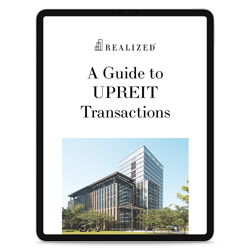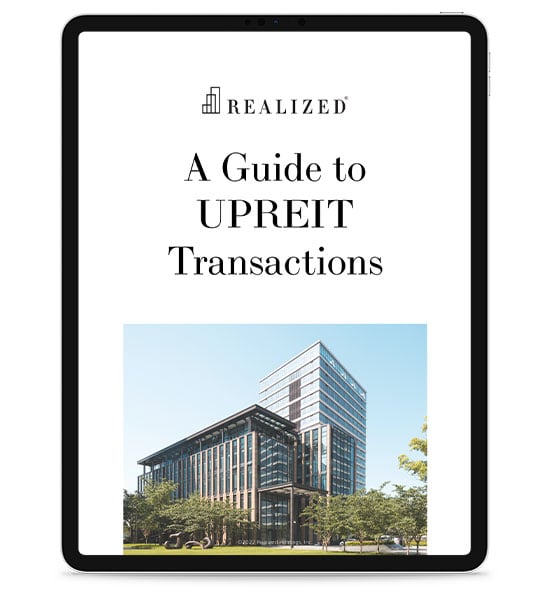
Mention the word “real estate exchange,” and what might come to mind is the 1031 exchange. This process falls under 26 U.S. Code § 1031 – “Exchange of Real Property Held for Productive Use or Investment.” The goal here is to help the investor “swap” a relinquished real estate asset into a replacement one. In this way, both depreciation capture and capital gains taxes can be deferred.
But there are other exchange methods. Getting back to the tax code, 26 U.S. Code § 721 – “Nonrecognition of Gain or Loss on Contribution” allows a real estate investor to contribute property to a real estate investment trust (REIT) in exchange for a partnership interest in that entity. In other words, that investor exchanges property through an Umbrella Partnership Real Estate Investment Trust arrangement – or UPREIT.
Rather than receiving cash or property in the process, the investor gains operating partnership (OP) units in the REIT. These OPs are equal in value to common stock.
Like the 1031 exchange, the 721 exchange allows the investor to defer capital gains taxes from the sale of real estate assets. But here’s one difference between the two:
- In a 1031 exchange, the investor pays capital gains taxes when they sell the replacement property
- In a 721 exchange, the investor pays capital gains taxes when:
- They sell the OP Units, or
- They convert the OP Units to REIT shares, or
- The acquiring operating partnership sells the contributed property
Another similarity is that both arrangements can help improve portfolio diversification. Furthermore, these exchanges can be useful for estate planning or passing on wealth to future generations.
However, the 721 exchange can allow for greater portfolio diversification than the 1031 exchange. Rather than exchanging into one or three properties (per the like-kind exchange), an UPREIT investor might benefit from the entire REIT portfolio’s diversity and performance.
Another difference is that the UPREIT process isn’t bound by the same rules and deadlines as a like-kind exchange. Unlike the 1031 exchange procedure, the investor doesn’t have to identify a replacement property/properties within 45 days of closing on the relinquished property. Nor does the investor need to close on that replacement property (or properties) within 180 days. Additionally, the 200% rule, 95% rule, or three-property rule doesn’t come into play with an UPREIT arrangement.
The challenge with the 721 exchange isn’t deadlines or finding/exchanging into properties of greater or equal value. Rather, the task involves finding a REIT interested in taking on the property in the first place. Additionally, once the investor is in that REIT as a partner, they can’t conduct another deferred tax exchange on the property sold to that REIT. They also have no voting rights in the REIT. They might benefit from passive income but end up with no control over the property.
The takeaway here is that both like-kind exchanges and UPREIT arrangements can provide tax-deferral benefits. However, successfully navigating both types of exchanges should be done only with the help of a knowledgeable professional.
This material is for general information and educational purposes only. Information is based on data gathered from what we believe are reliable sources. It is not guaranteed as to accuracy, does not purport to be complete and is not intended to be used as a primary basis for investment decisions. It should also not be construed as advice meeting the particular investment needs of any investor.
Costs associated with a 1031 transaction may impact investor’s returns and may outweigh the tax benefits. An unfavorable tax ruling may cancel deferral of capital gains and result in immediate tax liabilities.
Investors who have sold real estate and executed a 1031 Exchange into a DST may execute future 1031 Exchanges and continue to defer taxable gains. Alternatively, a client may enter into a transaction pursuant to IRS Code Section 721 (also known as an UPREIT transaction). In an UPREIT transaction, Clients will receive, at the REIT Sponsor’s option, cash or OP units. OP units are units of an operating partnership that is wholly owned by a REIT. If the client receives OP units, he or she has exchanged into a security and therefore no longer owns real estate and cannot execute another 1031 Exchange out of the OP units and into other real estate. However, pursuant to IRS Code Section 721, the UPREIT transaction into the OP units may qualify as a tax-deferred exchange. The disposition of their interest in OP units will result in a taxable transaction, including the recognition of their deferred capital gain and any depreciation recapture. The client’s gain will only be recognized upon sale or disposition of the OP units.
There is no guarantee that an UPREIT transaction will occur. The option for this transaction is at the discretion of the REIT Sponsor. Some DSTs allow the client to choose whether to take OP Units or cash. Clients should consult the prospectus and their advisor regarding the specifics.
All investments have an inherent level of risk. The value of your investment will fluctuate with the value of the underlying investments. You could receive back less than you initially invested and there is no guarantee that you will receive any income.
Realized does not provide tax or legal advice. This material is not a substitute for seeking the advice of a qualified professional for your individual situation.



